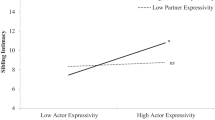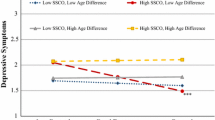Abstract
This study examined the role of sibling and friend characteristics in Mexican-American youth’s gender-typed characteristics (i.e., attitudes, interests, and leisure activities) in early versus middle adolescence using a sibling design. Mexican-American 7th graders (M = 12.51 years; SD = .58) and their older siblings (M = 15.48 years; SD = 1.57) from 246 families participated in home interviews and a series of seven nightly phone calls. Results revealed that younger/early adolescent siblings reported more traditional gender role attitudes than their older/middle adolescent siblings and older brothers were more traditional in their attitudes than older sisters. When comparing siblings’ gender-typed interests and leisure activities, boys reported more masculine orientations than girls and girls reported more feminine orientations than boys. Older brothers’ gender-typed characteristics were associated with the amount of time spent with and gender characteristics of their friendship group, but for younger brothers, sibling characteristics were associated with their gender-typed characteristics. In contrast, both sibling and friendship characteristics were significantly associated with older and younger sisters’ gender-typed characteristics. The discussion addressed the different correlates of older and younger sisters’ and brothers’ gender-typed characteristics.



Similar content being viewed by others
References
Adams, M., Coltrane, S., & Parke, R. D. (2007). Cross-ethnic applicability of the gender-based attitudes towards marriage and child rearing scales. Sex Roles, 56, 325–339. doi:10.1007/s11199-006-9174-0.
Aiken, L., & West, S. (1991). Multiple regression: Testing and interpreting interactions. London: Sage.
Banerjee, R., & Lintern, V. (2000). Boys will be boys: The effect of social evaluation concerns on gender-typing. Social Development, 9, 397–408. doi:10.1111/1467-9507.00133.
Berndt, T. J. (2004). Children’s friendships: Shifts over a half-century in perspectives on their development and their effects. Merrill Palmer Quarterly, 50, 206–223. doi:10.1353/mpq.2004.0014.
Blakemore, J. E. O., Berenbaum, S. A., & Liben, L. S. (2009). Gender development. New York: Taylor & Francis.
Bronfenbrenner, U., & Morris, P. A. (2006). The bioecological model of human development. In W. Damon & R. M. Lerner (Eds.), Handbook of child psychology, Vol. 1: Theoretical models of human development (6th ed., pp. 793–828). New York: John Wiley.
Buhrmester, D., & Furman, W. (1990). Perceptions of sibling relationships during middle childhood and adolescence. Child Development, 61, 1387–1398. doi:10.1111/j.1467-8624.1990.tb02869.
Crouter, A. C., Whiteman, S. D., McHale, S. M., & Osgood, D. W. (2007). The development of gender attitude traditionalist across middle childhood and adolescence. Child Development, 78, 911–926. doi:10.1111/j.1467-8624.2007.01040.x.
Feiring, C. (1999). Other-sex friendship networks and the development of romantic relationships in adolescence. Journal of Youth and Adolescence, 28, 495–512. doi:10.1023/A:1021621108890.
Foster, S. L., & Martinez, C. R. (1995). Ethnicity: Conceptual and methodological issues in child clinical research. Journal of Clinical Child Psychology, 24, 214–226. doi:10.1207/s15374424jccp2402_9.
Furman, W., & Buhrmester, D. (1992). Age and sex differences in perceptions of networks of social relationships. Child Development, 63, 103–115. doi:10.1111/j.1467-8624.1992.tb03599.x.
Galambos, N. L., Berenbaum, S. A., & McHale, S. M. (2009). Gender development in adolescents. In R. M. Lerner & L. Steinberg (Eds.), Handbook of adolescent psychology: Vol. 1. Individual bases of adolescent development (3rd ed., pp. 305–337). Hoboken, NJ: Wiley.
Garcia Coll, C., Crnic, K., Lamberty, G., Wasik, B. H., Jenkins, R., Garcia, H. V., & McAdoo, H. P. (1996). An integrative model for the study of developmental competencies in minority children. Child Development, 67, 1891–1914. doi:10.1111/j.1467-8624.1996.tb01834.x.
Hill, J. P., & Lynch, M. E. (1983). The intensification of gender-related role expectations during early adolescence. In J. Brooks-Gunn & A. C. Petersen (Eds.), Girls at puberty: Biological and psychosocial perspectives (pp. 201–228). New York: Plenum Press.
Hoffman, L. W., & Kloska, D. D. (1995). Parents’ gender-based attitudes toward marital roles and child rearing: Development and validation of new measures. Sex Roles, 32, 273–295. doi:10.1007/BF01544598.
Kenny, D. A., Kashy, D. A., & Cook, W. L. (2006). Dyadic data analysis. New York: Guilford.
Kulis, S., Marsiglia, F. F., & Hecht, M. L. (2002). Gender labels and gender identity as predictors of drug use among ethnically diverse middle school students. Youth and Society, 33, 442–475. doi:10.1177/0044118X02033003005.
Leaper, C., & Valin, D. (1996). Predictors of Mexican American mothers’ and fathers’ attitudes toward gender equality. Hispanic Journal of Behavioral Sciences, 18, 343–355. doi:10.1177/07399863960183005.
Martin, C. L., Kornienko, O., Schaefer, D. R., Hanish, L. D., Fabes, R. A., & Goble, P. (2013). The role of sex of peers and gender-typed activities in young children’s peer affiliative networks: A longitudinal analysis of selection and influence. Child Development, 84, 921–937. doi:10.1111/cdev.12032.
McHale, S. M., Crouter, A. C., & Bartko, W. T. (1992). Traditional and egalitarian patterns of parental involvement: Antecedents, consequences, and temporal rhythms. In D. L. Featherman, R. M. Lerner, & M. Perlmutter (Eds.), Life-span development and behavior (Vol. 2, pp. 49–81). New York: Erlbaum.
McHale, S. M., Crouter, A. C., & Tucker, C. J. (1999). Family context and gender role socialization in middle childhood: Comparing girls to boys and sisters to brothers. Child Development, 70, 990–1004. doi:10.1111/1467-8624.00072.
McHale, S. M., Crouter, A. C., & Whiteman, S. D. (2003). The family contexts of gender development in childhood and adolescence. Social Development, 12, 125–148. doi:10.1111/1467-9507.00225.
McHale, S. M., Updegraff, K. A., Helms-Erikson, H., & Crouter, A. C. (2001). Sibling influences on gender development in middle childhood and early adolescence: A longitudinal study. Developmental Psychology, 37, 115–125. doi:10.1111/1467-8624.00278.
McHale, S. M., Updegraff, K. A., Shanahan, L., Crouter, A. C., & Killoren, S. E. (2005). Culture, gender, and family dynamics: Differential treatment in Mexican American families. Journal of Marriage and Family, 67, 1259–1274. doi:10.1111/j.1741-3737.2005.00215.x.
McWhirter, E. H., Hackett, G., & Bandalos, D. L. (1998). A causal model of the educational plans and career expectations of Mexican-American high school girls. Journal of Counseling Psychology, 45, 166–181. doi:10.1037/0022-0167.45.2.166.
Orellana, M. F. (2003). Responsibilities of children in Latino immigrant homes. New Directions for Youth Development, 100, 25–39. doi:10.1002/yd.61.
Perry, D. G., & Pauletti, R. E. (2011). Gender and adolescent development. Journal of Research on Adolescence, 21, 61–74. doi:10.1111/j.1532-7795.2010.00715.x.
Peterson, A. C., Crockett, L., Richards, M., & Boxer, A. (1988). A self-report measure of pubertal status: Reliability, validity, and initial norms. Journal of Youth and Adolescence, 17, 117–133. doi:10.1007/BF01537962.
Pleck, J., & O’Donnell, L. N. (2001). Gender attitudes and health risk behaviors in urban African American and Latino early adolescents. Maternal and Child Health Journal, 5, 265–272. doi:10.1023/A:1013084923217.
Qin-Hilliard, D. B. (2003). Gendered expectations and gendered experiences: Immigrant students’ adaptation in school. New Directions in Youth Development, 100, 91–110. doi:10.1002/yd.65.
Raffaelli, M., & Ontai, L. L. (2004). Gender socialization in Latino/a families: Results from two retrospective studies. Sex Roles, 50, 287–299. doi:10.1023/B:SERS.0000018886.58945.06.
Ruble, D. N., Martin, C. L., & Berenbaum, S. A. (2006). Gender development. In N. Eisenberg (Ed.), Handbook of child psychology: Vol. 3, Personality and social development (6th ed.) (pp. 858–932). New York: Wiley.
Serbin, L. A., Powlishta, K. K., Gulko, J., Martin, C. L., & Lockheed, M. E. (1993). The development of sex-typing in middle childhood. Monographs of the Society for Research in Child Development, 58, 1–99. doi:10.2307/1166118.
Umaña-Taylor, A. J. (2009). Research with Latino early adolescents: Strengths, challenges, and directions for future research. Journal of Early Adolescence, 29, 5–15. doi:10.1177/0272431608324481.
Updegraff, K. A., McHale, S. M., Killoren, S. E., & Rodriguez, S. A. (2011). Cultural variations in sibling relationships. In J. Caspi (Ed.), Sibling development: Implications for mental health practitioners (pp. 83–105). New York: Springer.
Updegraff, K. A., McHale, S. M., Whiteman, S. D., Thayer, S. M., & Crouter, A. C. (2006). The nature and correlates of Mexican American adolescents’ time with parents and peers. Child Development, 77, 1470–1486. doi:10.1111/j.1467-8624.2006.00948.x.
Updegraff, K. A., McHale, S. M., Whiteman, S. D., Thayer, S. M., & Delgado, M. Y. (2005). Adolescent sibling relationships in Mexican American families: Exploring the role of familism. Journal of Family Psychology, 19, 512. doi:10.1037/0893-3200.19.4.512.
Updegraff, K. A., Umaña-Taylor, A. J., McHale, S. M., Wheeler, L. A., & Perez-Brena, N. J. (2012). Mexican-origin youth’s cultural orientations and adjustment: Changes from early to late adolescence. Child Development, 83, 1655–1671. doi:10.1111/j.1467-8624.2012.01800.x.
U.S. Census Bureau. (2000). American FactFinder. Available at: www.census.gov.
U.S. Census Bureau. (2010). 2008 American Community Survey 1-Year Estimates. U.S. Census Bureau News. Retrieved May 6, 2010, from http://www.census.gov/Press-Release/www/releases/pdf/cb10ff-08_cincodemayo.pdf.
Valenzuela, A. (1993). Liberal gender role attitudes and academic achievement among Mexican-origin adolescents in two Houston inner-city Catholic schools. Hispanic Journal of Behavioral Sciences, 15, 310–323. doi:10.1177/07399863930153002.
Acknowledgments
We are grateful to the families and youth who participated in this project, and to the following schools and districts who collaborated: Osborn, Mesa, and Gilbert school districts, Willis Junior High School (Chandler School District), Supai and Ingleside Middle Schools (Scottsdale School District), St. Catherine of Siena, St. Gregory, St. Francis Xavier, St. Mary-Basha, and St. John Bosco. We thank Susan McHale, Ann Crouter, Mark Roosa, Nancy Gonzales, Roger Millsap, Ji-Yeon Kim, Jennifer Kennedy, Sarah Killoren, Devon Hageman, Melissa Delgado, Emily Cansler, Lilly Shanahan, Shawna Thayer for their assistance in conducting this investigation. Funding was provided by NICHD grant R01HD39666 (Kimberly Updegraff, Principal Investigator) and the Cowden Fund to the T. Denny Sanford School of Social and Family Dynamics at ASU.
Author information
Authors and Affiliations
Corresponding author
Rights and permissions
About this article
Cite this article
Perez-Brena, N.J., Wheeler, L.A., Updegraff, K.A. et al. Mexican-American Adolescents’ Gender-Typed Characteristics: The Role of Sibling and Friend Characteristics. Arch Sex Behav 44, 1255–1268 (2015). https://doi.org/10.1007/s10508-014-0447-3
Received:
Revised:
Accepted:
Published:
Issue Date:
DOI: https://doi.org/10.1007/s10508-014-0447-3




